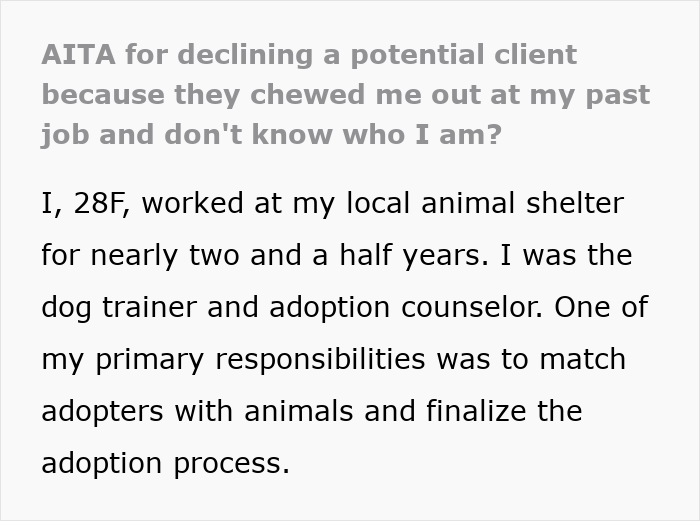More than 3 million dogs end up at shelters in the U.S. every year. That’s why it’s really good to adopt and not shop when getting a pet. However, it’s crucial to understand what you’re getting yourself into with your potential new pet.
A former animal welfare worker has told how a woman blatantly ignored her warnings that a particular dog had a range of behavior issues. And had been returned to the shelter numerous times. A year later, the woman contacted a dog trainer, begging for help and trash-talking the shelter. Little did she know she was speaking to the very person who’d finalized the adoption.
Even some of the cutest dogs can have behavior issues that make them aggressive

Image credits: kamchatka (not the actual photo)
One woman went against the advice of an animal shelter, and her decision has now come back to bite her





Image credits: katemangostar (not the actual photo)





Image credits: mariadevicente (not the actual photo)




Image credits: undeterminedcreature
The dog trainer provided a bit more info when prompted




Separation anxiety is one of the most common behavioral disorders in dogs
I’ve had a dog scratch through wooden floorboards, and even chew a hole in the front door. He was adopted from a rescue organization. In retrospect, I should have renamed him Shadow. Because he could win the follow-me-everywhere Olympics, if there ever were such a thing. This dog even jumped right into the shower with me during his first week home.
Thankfully, it’s been a few years now, and he’s grown to understand that I always come back. And that I am not the same family that dropped him at a shelter at the age of seven and drove away – never to be seen again. Don’t get me wrong. His separation anxiety is still there. Just nowhere near as bad.
In case you’re not familiar with the term, separation anxiety is triggered when dogs become upset because of separation from their guardians, the people they’re attached to.
While some dogs will bark nonstop when left alone (even for a few minutes), others can take it to the extreme. “Escape attempts by dogs with separation anxiety are often extreme and can result in self-injury and household destruction, especially around exit points like windows and doors,” explains the American Society for the Prevention of Cruelty to Animals (ASPCA).
The ASPCA adds that some dogs suffering from separation anxiety become agitated when their guardians prepare to leave. Others seem anxious or depressed prior to their guardians’ departure or when their guardians aren’t present. Some try to prevent their guardians from leaving.
“Usually, right after a guardian leaves a dog with separation anxiety, the dog will begin barking and displaying other distress behaviors within a short time after being left alone—often within minutes,” notes the site. “When the guardian returns home, the dog acts as though it’s been years since he’s seen his mom or dad!”
Here’s what to do if your dog freaks out about being left alone
The main goal when treating a dog with separation anxiety is to teach the dog to enjoy, or at least tolerate, being left alone. “This is accomplished by setting things up so that the dog experiences the situation that provokes his anxiety, namely being alone, without experiencing fear or anxiety,” the ASPCA says.
PetMD suggests desensitizing your dog to pre-departure cues to help reduce their anxiety. These include things like picking up your car keys, packing your lunch, putting on your shoes, or grabbing your purse. Basically, the behaviors your dog notices before you leave the house.
“These actions can be a significant source of distress for your dog. You can help decrease your dog’s anxiety by changing up your routine, performing these actions when you are not leaving, or avoiding as many of them as possible,” advises the PetMD site. “You can also offer your dog a special treat to help distract them as you are preparing to leave.”
The ASPCA adds that providing lots of physical and mental stimulation is a vital part of treating many behavior problems, especially those involving anxiety. “Exercising your dog’s mind and body can greatly enrich his life, decrease stress, and provide appropriate outlets for normal dog behaviors,” explains the society’s site. “Additionally, a physically and mentally tired dog doesn’t have much excess energy to expend when he’s left alone.”
Again, the ultimate goal is to teach your dog that being alone is not a bad thing. “To increase their confidence, gradually increase the amount of time your dog spends alone,” suggests PetMD, adding that this requires patience and is often the most challenging part of behavior modification.
You’ll find some more tips on dealing with separation anxiety here. Of course, if you and Fido are really at your wits’ end, you can always reach out to a professional dog behaviorist. If you haven’t been trash-talking them, they should be more than willing to help.
“Champagne dreams”: many agreed that the trainer should not work with the woman
























